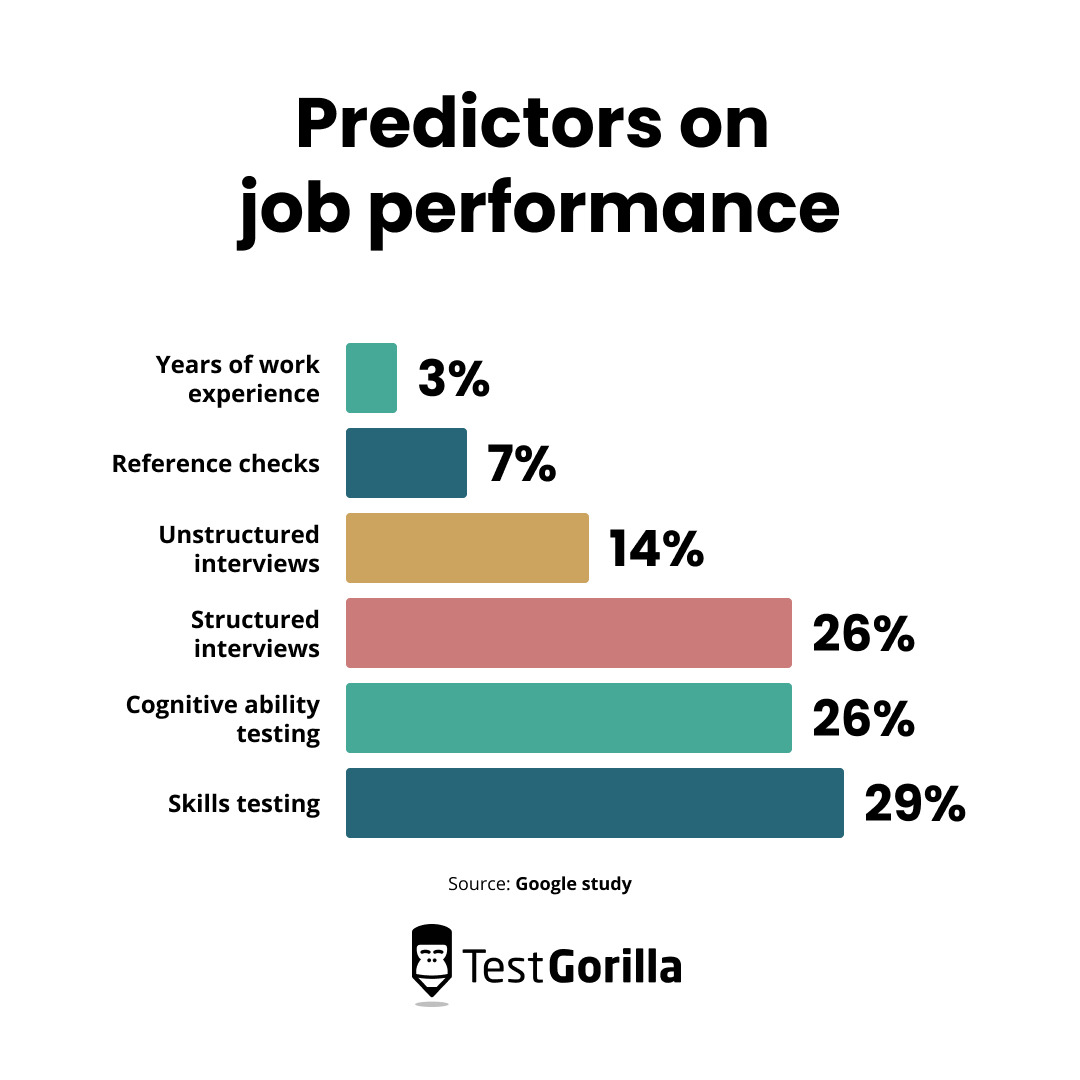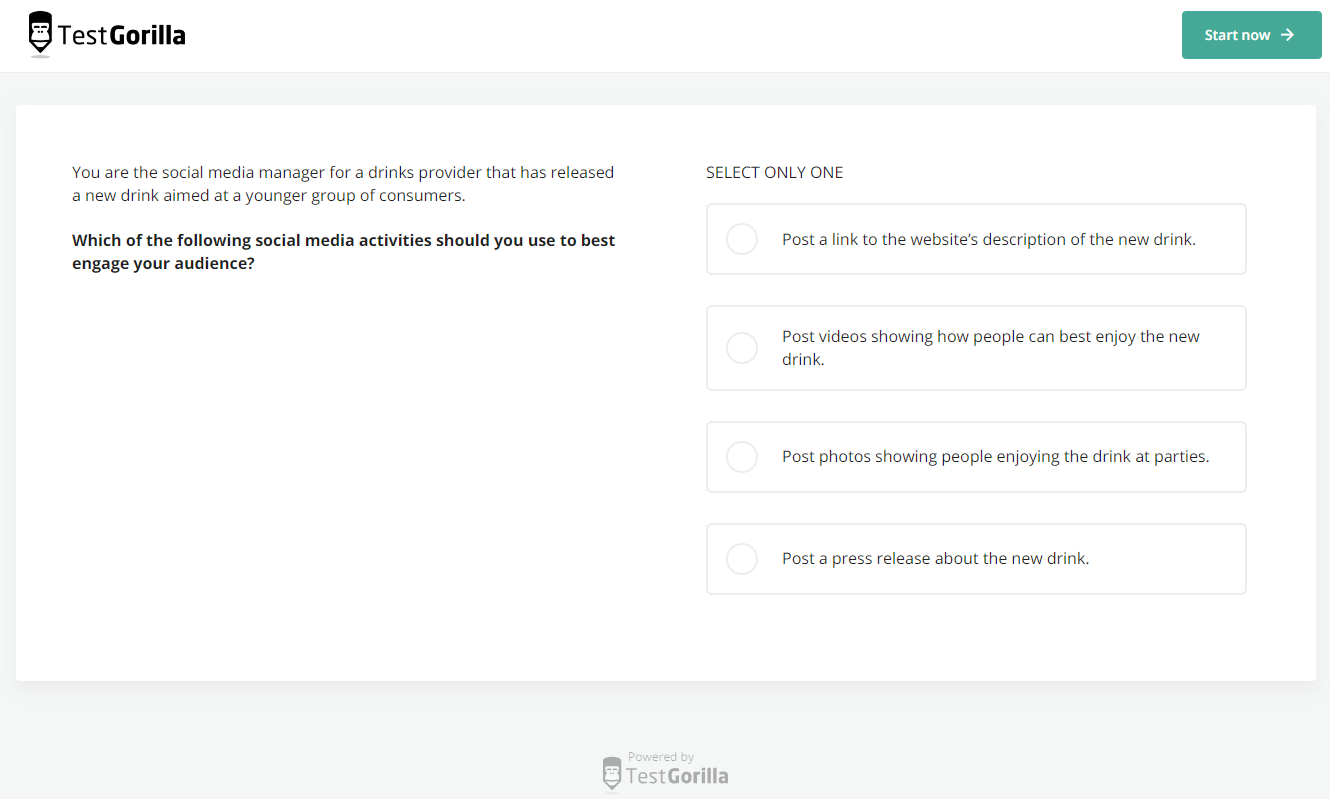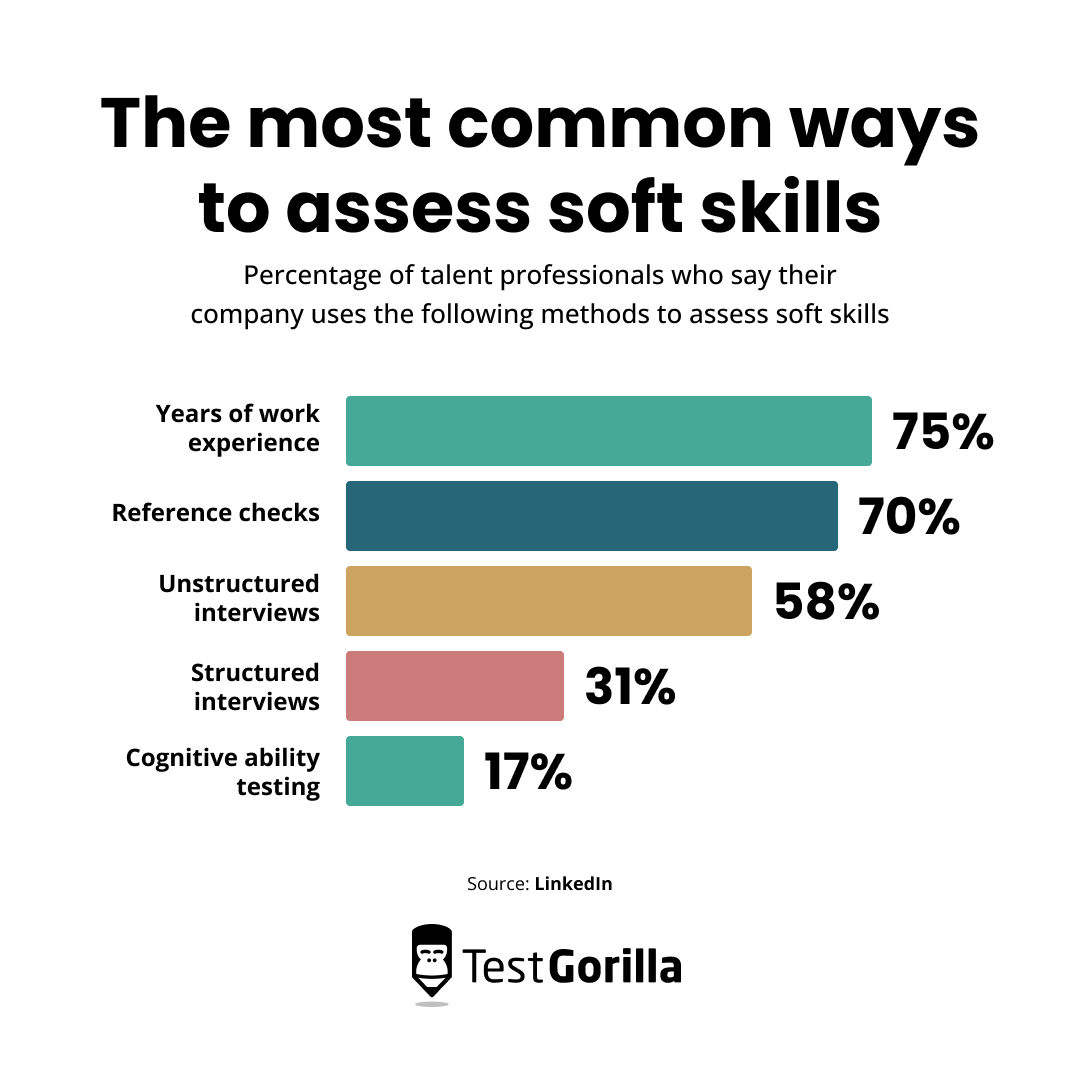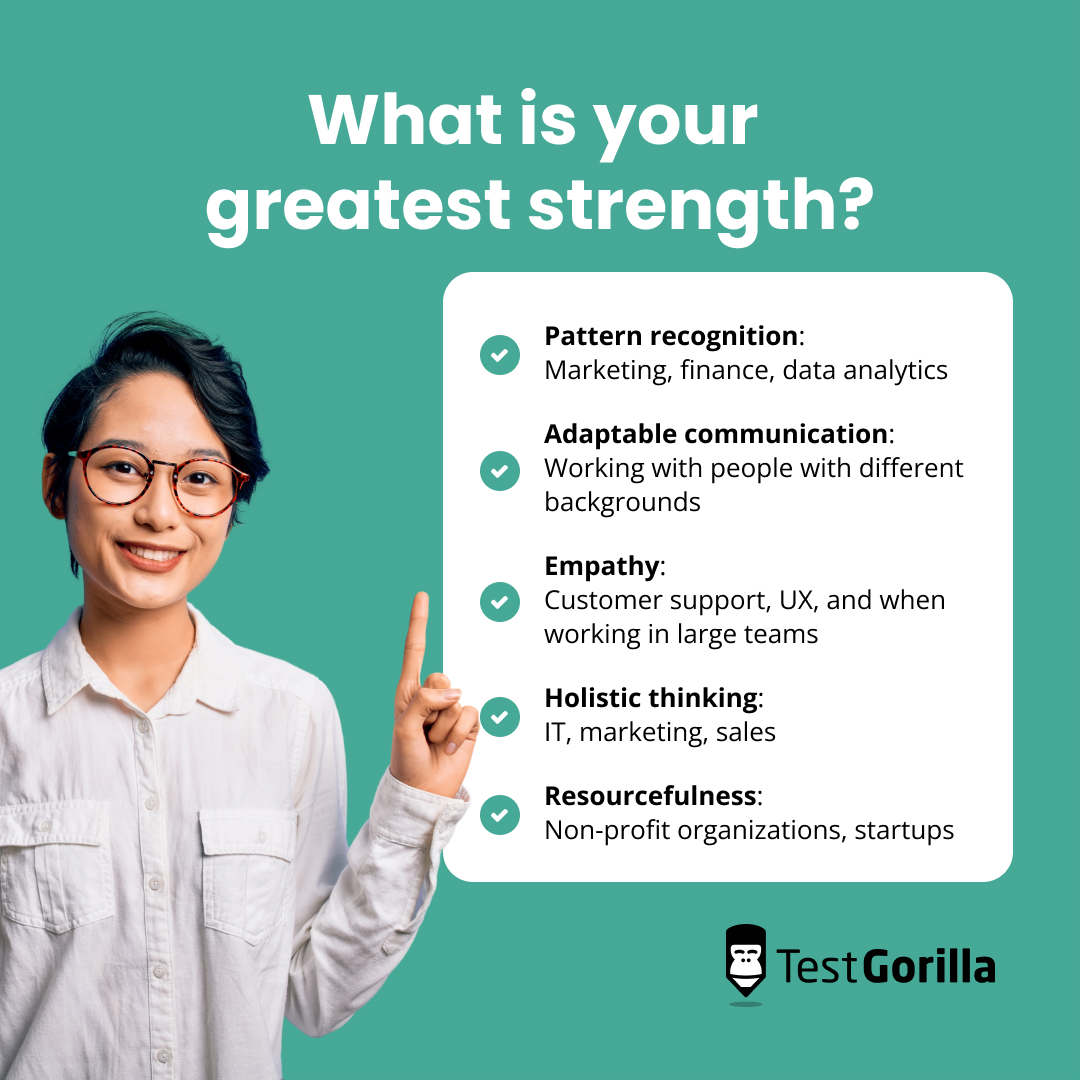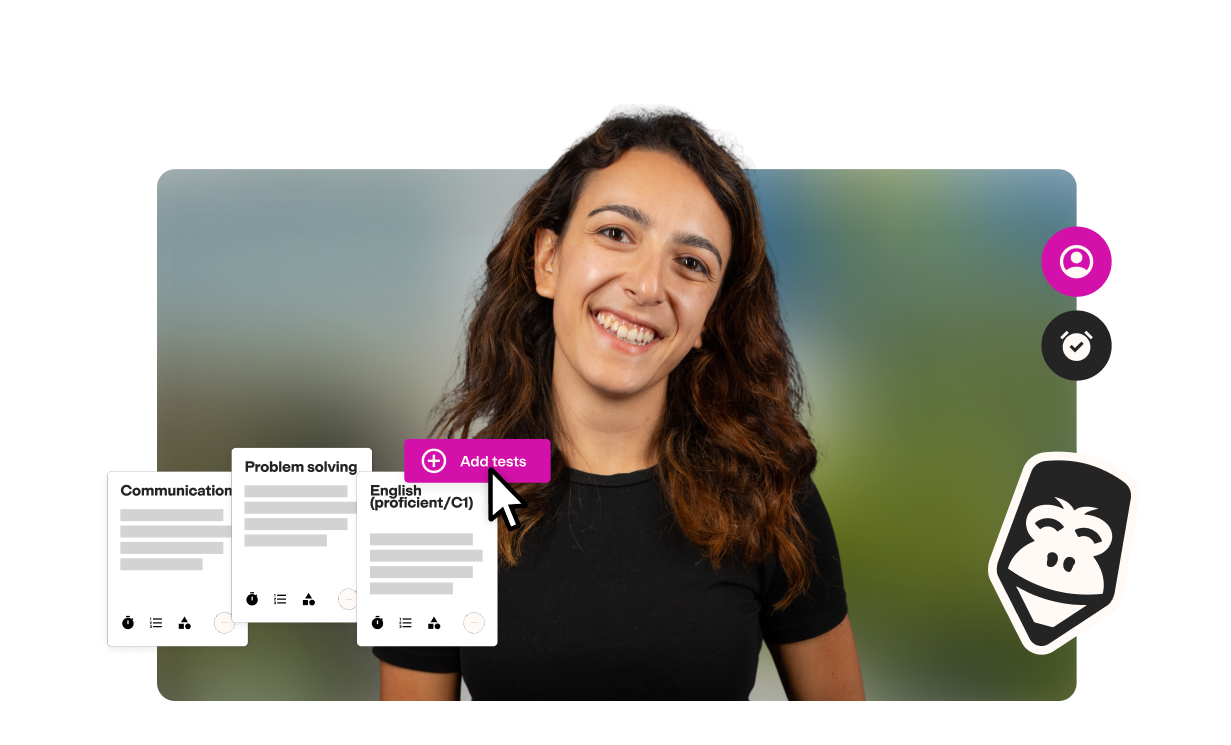All hiring managers like to believe they approach every interview with the utmost professionalism and laser focus.
But let’s be honest: If there was one question you’d zone out for when conducting an interview, you know which one it would be.
“What are your biggest strengths and weaknesses?”
It’s cliché and an invitation for a pre-rehearsed answer. However, it’s still one of the most important job interview questions you can ask.
In this blog post, we’ll show you how to overcome this dilemma and assess candidates’ strengths and weaknesses accurately without being bored by canned answers.
Table of contents
- How to use this guide
- What candidates’ strengths and weaknesses should you look for?
- 7 tips to ask better questions, get better answers, and hire the right talent
- Candidate strengths and weaknesses: a guide for job seekers
- For deep insights into candidates’ strengths and weaknesses, build a holistic hiring process
How to use this guide
This guide is mainly for hiring managers and recruiters who want to accurately assess candidates’ strengths and weaknesses in job interviews.
If you’re one of those candidates, this is still an informative read, but, more importantly, there’s a separate section just for you at the end.
If you’re a hiring manager or recruiter, good news – you’re in the right place. In this guide, we explain how to assess candidates in an interview and identify the strengths and weaknesses you’re looking for. You can also skip to the end to gain insights into the candidate’s perspective.
What candidates’ strengths and weaknesses should you look for?
Knowing a candidate’s strengths and weaknesses is essential in determining whether they are a good match for your company. Before you even make the effort to come up with creative ways to assess strengths and weaknesses, you first need to figure out what you’re looking for.
To do that, you need to make sure you’re clear on:
The expectations of the role on offer, including the job description
The business you’re hiring for, including its core competencies, culture, values, and projected growth
Start by identifying your organization’s core competencies, especially if you’re an in-house hiring manager.
A core competency area is something your company does that defines its proposition. When C.K. Prahalad and Gary Hamel originally defined them in 1990, core competencies had to meet three requirements:
They must apply to a wide variety of markets
They need to benefit the customer
They must be difficult for competitors to imitate
This list helps you zero in on your company’s strengths that set it apart from the rest – and will enable you to identify great candidates who can contribute to your business’ mission.
Essentially, you need to first look at the big picture – your company’s strengths – and then focus on each role and the individual strengths you need to hire for.
Next, take a look at your goals over the coming weeks, months, and years and perform a skills gap analysis to determine where you currently fall short.
Let’s say you’re looking for a social media manager. The core skills you need might include:
Copywriting
Design
Customer service
Adaptability
Project management
Platform knowledge
However, suppose one of your organization’s core competencies is creating engaging in-person events, and you want to translate this to the digital space.
In that case, an extra-valuable strength might be audience management, which you would have failed to identify, had you focused only on the role itself.
7 tips to ask better questions, get better answers, and hire the right talent
Most candidates have googled “how to answer common interview questions” – or asked ChatGPT about it.
If they’re smart, they probably know not to answer a “What is your biggest weakness?” question by saying, “I’m just such a perfectionist” or “I am too detail-oriented.”
Instead, they might say something slightly different but equally humble-braggy, like, “I focus too much on details, and it can cause me stress when meeting a deadline.”
Still, the result is basically the same – these answers don’t provide a deep look into the candidate.
But that’s not how it has to be. Here are seven tips to gain valuable insights into candidates’ strengths and weaknesses during the interview process.
1. Use pre-interview testing to inform your interview approach
The best time to start gathering information on your applicants’ skills is before the interview stage even starts. The best method? Pre-employment skills tests.
These online tests replace the usual CV-screening process as the first stage of job applications. They offer many advantages:
They accurately measure relevant skills – tests are created by subject-matter experts and evaluated by a team of QA and psychometrics experts
They’re standardized, so you can easily compare and filter candidates
You can create an assessment of a few tests to evaluate all the key areas you identified for the role
Skills assessments are one of the best ways to predict job performance. They’re more accurate than looking at a candidate’s work experience or checking references, and when used in combination with interviews, are truly a winning combination. The most successful companies realize that.
For example, Google uses a combination of skills tests and project work to evaluate applicants before they even get to interviewing applicants. IBM's hiring process also involves skills assessments that come before interviews.
Currently, more than 10,000 companies have optimized their recruitment with the help of TestGorilla, including companies like Revolut, Sony, and H&M.
Check out our case studies to find out more about the different ways in which companies have leveraged our skills-testing platform to achieve better hiring outcomes.
In short, instead of spending half the interview probing into whether applicants can actually do the things they claim they can do in resumes, test for those skills before interviewing candidates.
This way, during the actual interviews, you can prioritize assessing the unique strengths and soft skills they can bring to the table. You can also use highly targeted questions to assess more technical skills, if needed.
Here’s a sample test question from our Social Media Management test:
This test helps assess candidates’ strengths and weaknesses in terms of actual skills required for the role – which enables you to delve even deeper when you get to interviewing the best talent.
Our test library contains over 300 tests that you can use to evaluate anything from motivation to role-specific, technical skills.
With our free plan, you get access to 10 of our most popular tests, which you can start using today.
2. Use a structured interview approach
In a traditional, unstructured interview, you usually don’t have much of a plan. You might have some notes written down, but you probably don’t have a list of all the specific questions you’re going to ask.
This approach has the advantage of making your conversation more spontaneous and organic. It’s a good way to find out unexpected things about the candidate. At later stages in the interview process, it can also be a good way of assessing how candidates would fit into your culture.
However, we advocate using structured interview techniques, especially in the earlier stages of candidate selection. In a structured interview, you create a template and:
Ask all candidates the same questions
Ask all questions in the same order
Score each answer based on predetermined criteria
This method brings objectivity into the interviewing process and ensures that you:
Discuss with everyone the most crucial topics you’ve identified at the start of your hiring process
Assess all candidates’ strengths and weaknesses comprehensively
Reduce bias and are able to build a truly diverse and inclusive workforce, especially when you use skills assessments first
In fact, according to the Harvard Business Review, it’s one of the best methods for achieving these aims.
Iris Bohnet, Harvard professor and author of the book “What Works: Gender Equality by Design”, recommends the following best practices for reducing bias in the interview stage:
Score each answer immediately after hearing it: If you leave scoring for later, you’ll just remember the most vivid examples, i.e. the best and the worst answers.
Compare candidates horizontally: Compare everyone’s answers to question one, then to question two, and so on. This helps you identify and compare exactly where each candidate’s strengths and weaknesses lie.
Submit scores before you discuss applicants with others: If you have more than one interviewer, get them to submit their assessments before meeting to discuss candidates so that peer pressure doesn’t affect their answers.
Standardizing interview questions makes your shortlisting process easier and reduces overall bias. Here’s an example:
Imagine you’re conducting unstructured interviews for a role you know requires strong collaboration skills because the hire needs to work across two teams.
You have an instant rapport with Candidate A. You talk a lot about their interests, which are similar to yours, and they seem like a good culture fit. You’re pretty sure they’d be a good team player based on the personality traits you observe, but you have no real evidence supporting your hunch.
Candidate B is more serious. You ask them directly about collaboration skills, and they give you a good answer, but you’re not sure they’d gel with team members because you couldn’t connect to them on a more personal level.
How would you compare these two candidates? Probably by wasting time on further interviews, right? And which one are you more likely to choose, despite having no real proof they’re the better fit?
We rest our case.
3. Use a mix of situational and behavioral questions
Behavioral interview questions focus on what candidates have done in the past. They start with phrases like “Tell us about a time when…” and “What’s your process for…”
On the other hand, situational interview questions are all about hypothetical situations, i.e. what your candidate would do if they were confronted with a particular scenario. They start with phrases like “Imagine you were…” and “What would you do if…”
Let’s take our earlier example of social media management. Here’s what behavioral and situational questions might look like if you wanted to test influencer management skills:
Question type | Starts with | Example for a social media manager role |
Situational | - Imagine you were doing x … - What would you do if you need to achieve y… | What criteria would you use when looking for appropriate influencers if we were to implement a brand ambassador program? |
Behavioral | - Tell us about a time when… - What’s your tested and proven process for… | Tell us about a time when you successfully leveraged an influencer partnership to improve brand awareness. |
It’s never too soon to start implementing this strategy. Your peers are probably already doing it, and if you’re struggling for inspiration, don’t worry. We have lists of questions for pretty much any role you can think of on our blog, including interview questions for social media managers.
4. Prime the question to get real insights into candidates strengths and weaknesses
We can dance around it all we like, but sometimes you’re going to have to ask cliché questions like:
Tell me about yourself.
Why do you want this job?
What’s your biggest strength?
What’s your biggest weakness?
…and so on.
The problem with that approach is that cliché questions often invite cliché answers. To improve your chances of getting a truly honest answer and not just a canned response, we advise you to prime the question.
By priming the question – in other words, setting expectations so that candidates don’t just reach for easy answers – you can get responses that reflect more directly the things you want to uncover, i.e. specific candidate strengths and weaknesses.
Here are ways you might prime the questions we outlined above:
Cliché interview question | Ways to “prime” the question |
Tell me about yourself. | Tell me something about yourself that I don’t know from your resume. |
Why do you want this job? | What personal goals will this role help you achieve? |
What’s your biggest strength? | What’s something that other people in this role or industry don’t have that you do? |
What’s your biggest weakness? | What’s your biggest weakness? I don’t want to hear an answer that turns it into a strength. I want to know where you need the most support so that we can help you grow if we hire you. |
We know some of the above phrases are quite intense. But when presented right, they’ll not only jolt the candidate into giving a more thoughtful, spontaneous reply, but also show them that you actually want to understand who they are – and not just get the typical “correct” responses.
5. Use the candidate’s answer to dig deeper
When asking broad questions, follow up with more probing questions to dig deeper into each candidate’s strengths and weaknesses.
When assessing candidates for a job, you want to:
Verify that there is evidence for their answer in their work history
Assess their humility, self-awareness, and capabilities for self-reflection and self-criticism
Here’s how you might do this for a data analyst position:
Initial question | Answer | Potential follow-up questions |
What’s your biggest strength – something that other people in this role might not have? | I have strong presentation and communication skills. I’m proficient at translating complex data concepts into actionable insights. | Tell us about a time you received recognition for these skills. Give us an example of a complex finding you translated for a layman audience. |
What’s your biggest weakness? Rather than describing something that’s actually a strength, tell us about something that we could help you improve if we were to hire you. | I only have a beginner’s knowledge of Python programming. I would need support and training to progress to bigger and more complex projects. | Tell us about a time this caused issues in your work. How did you handle this? What proactive steps have you taken to fill in your knowledge gaps? |
6. Link the answer back to your company
In your follow-up questions and throughout the interview, it’s essential to link candidate strengths and weaknesses not just to the role or team they’ll be joining but to the business as a whole.
This means assessing whether applicants’ strengths align with the core competencies you have identified – and whether they would thrive within your company’s current setup.
For instance, you might ask a candidate who appears to have strong team-building and management skills to name three strategies they’ve implemented to run teams effectively in a hybrid environment.
It also means pausing to consider whether you have the right upskilling resources to address their weaknesses. You might ask candidates if they’re familiar with your employee development programs and which parts interest them the most.
Perhaps most importantly, to assess candidates effectively, link questions to your company culture and values.
This enables you to hire for culture add rather than culture fit: Instead of aiming to replicate the strengths you already have in your team, aim to diversify your organization’s overall skill set and ways of thinking.
Evidence shows that creating a diversity of thought in a team leads to deeper thinking than is possible in a homogeneous one – a phenomenon called “cognitive elaboration.”
This can lead to greater innovation and keeps your company culture from stagnating, especially when supported by pre-interview testing.
7. Look beyond the individual questions
Finally, make your questions multitask.
Look at how candidates answer the questions and score candidates’ responses horizontally, comparing the content of their answers to each question individually.
For example, if you want to test a candidate’s ability to prepare, you should tell them the questions you’ll be asking beforehand. This might go against standard advice, but if preparation is a key strength for the role, it enables them to show you their proficiency in this area.
On the other hand, if you’re hiring for a role that requires candidates to think on their feet, use behavioral questions as a guide for how they respond to real-time problem-solving.
When assessing candidates for a job, ask yourself questions like:
How do they break down the problem? Do they work backward from the desired outcome, or do they work their way through step by step?
How do they communicate the solution? Do they tell you their whole thought process, or do they work it out silently before presenting an answer?
Do they ask questions, or do they try to work the problem out on their own?
There isn’t a right or wrong answer to any of those questions – it all depends on the role for which you’re hiring.
If you’re conducting a video interview for a virtual role, this can also provide you with a chance to learn more about the candidate’s remote working skills.
For instance, you might focus on emotional intelligence, how candidates react to distractions, or how they compensate for the artificiality of a Zoom meeting.
We know this is a lot to compute on the spot, so when you’re crafting your structured or semi-structured interview questions, prioritize those that might serve more than one function.
Finally, don’t book interviews back to back – make sure you have time to jot down your overall impressions of each candidate while they’re still fresh in your mind.
Candidate strengths and weaknesses: a guide for job seekers
Maybe you’re not a hiring manager but a stressed out candidate – and you want to make sure you’re prepared for your next interview.
Here’s a crash course on how to shine in your job interview’s strengths and weaknesses section.
Why do recruiters ask questions about candidates’ strengths and weaknesses?
Obviously, recruiters want to know a candidate’s strengths and weaknesses so that they can predict whether or not they’ll excel in the role.
But let’s break down what that actually means. This will help you understand where recruiters are coming from and what they’re looking to evaluate when interviewing you.
Here’s why recruiters want to know your strengths:
To assess how well you’d succeed in the role
To see which skills gaps you plug in their team
To find out if you could add to the company’s culture or promote innovation
To evaluate your growth potential and see if you could be a good fit for future leadership roles
And here’s why they want to know your weaknesses:
To see if another member of the team could compensate for these areas
To get a better understanding of your onboarding needs
To ascertain if they have the necessary upskilling resources to help you grow
To evaluate your self-awareness and self-reflection capabilities
Sample answers about strengths: How should I answer “What is your greatest strength?”
We don’t want to give you a cookie-cutter “examples of strengths” and “examples of weaknesses” answer.
If you’ve read the rest of this post, you know that there’s no “right” answer to this question and that it all depends on many factors, including:
The role’s requirements
The company culture
The skill set of the team you’re joining
The best advice we can give you is to be honest, think critically about not just what your strengths are but which ones set you apart from other candidates, and finally, give clear examples of when you’ve actually shown this trait.
But, if you need some ideas to jumpstart the reflection process, here are some strengths that won’t make interviewers yawn:
Strength | Explanation | Ideal for |
Pattern recognition | You have an innate ability to see patterns where others see chaos. | Roles where strong analytical and problem-solving skills are needed.
Examples: Roles in marketing, finance, data analytics. |
Adaptable communication | You can easily adapt your communication style to your audience, ensuring everyone's on the same page. The interview is an ideal opportunity to demonstrate this strength. | Roles where you need to communicate with people from different teams or with very different backgrounds.
Examples: Roles in customer support, B2B sales, HR. |
Empathy | You're an empathetic person who's highly attuned to others' emotions and needs. | Customer-facing roles or roles where teamwork is essential.
Examples: Roles in customer support, UX, and when working in large, cross-functional teams. |
Holistic thinking | Instead of focusing on one aspect of a problem, you see how everything connects, ensuring all elements of a solution are considered. | Leadership roles or when working with complex systems.
Examples: Roles in IT, marketing, sales. |
Resourcefulness | You can achieve a lot with very limited resources. | High-paced environments where stakes are high but resources are limited.
Examples: Roles in non-profit organizations, startups. |
Always tailor your answers to your actual strengths and to the role itself.
Sample answers about weaknesses: How should I answer “What is your greatest weakness?”
You’ll find lots of advice online telling you to turn this question to your advantage.
“Choose a weakness that’s secretly a strength” is such a common piece of advice that it’s now a cliché. Like, for example, being a perfectionist, being too passionate or independent, or the boldest example answer of all: “I don’t have any weaknesses. My confidence helps me overcome anything.”
…Yikes.
In fact, recruiters are looking to assess your ability to self-reflect, take action to address weaknesses, and discuss difficult topics. They’re also trying to gauge whether they can help you overcome potential weaknesses, i.e. whether they have the right learning and development resources to help you grow.
They’re not looking for yet another person who tells them that they’re a perfectionist.
Here are some examples of weaknesses:
Over-optimism: You sometimes view challenges with too much optimism, which might make you underestimate potential risks.
People-pleasing: Being highly attuned to others' needs can lead to conflict avoidance and lead to worse outcomes when you need to negotiate with multiple decision makers.
Hyper-focus: You can become so engrossed in details that you might miss the bigger picture.
Roles where constant shifts between micro and macro perspectives are required.
Novelty-seeking: You're always on the lookout for new ways of doing things, which can mean not always sticking with established processes.
Excessive introspection: You spend a lot of time self-reflecting. This slows down your work and can lead to analysis paralysis.
Over-reliance on feedback: You always seek feedback before moving forward. This makes you dependent on others.
Don’t use those verbatim! Your next employer might be reading the same article right now. Instead, use the examples above as a starting point to reflect on your own weaknesses.
Here are ways you can describe your weaknesses to employers without putting them off:
Be honest: Avoid any of the standard responses you can find online; use this opportunity to self-reflect and talk about an actual weakness you have.
Be prepared with examples: Explain how you overcame this weakness when it tripped you up in your previous job
Use this as an opportunity to talk about your growth: Emphasize any formal training or mentorship you have undergone, whether inside or outside of work, to help you build strength in this area
Check if the company can support you: Research development opportunities the company offers that would enable you to grow
Talk about your development targets in this area: Explain how this might map onto your future at their business – for instance, using their learning and development opportunities to develop the necessary skills to move into a cross-functional role.
For deep insights into candidates’ strengths and weaknesses, build a holistic hiring process
We’ve talked a lot about how to find out what you need to know about candidates. But you’ve also answered a lot of your own questions too, including:
What candidates’ strengths and weaknesses do I need to look for?
How can I prepare for interviews to assess these strengths and weaknesses?
What questions do I need to ask?
What other signs tell me more about candidates’ strengths and weaknesses?
You now know how to assess candidates in an interview in a way that helps you gain real insights into their qualities and the areas where they need to improve. That’s much better than getting boring, clichéd answers that don’t give you any real information, right?
Skills tests can be an invaluable addition to your current recruitment process and enable you to assess applicants’ skills in an objective and fair way, before you even talk to them. Our test library features 300+ skills tests you can choose from – and you can combine up to five tests in a single assessment.
This way, you can easily identify the best talent and get a good idea of each candidate’s strengths and weaknesses prior to interviews – and ask even more precise and targeted questions.
Get a free demo to see for yourself why 10,000+ companies are using TestGorilla to improve their candidate selection process – or try out our free plan and start assessing candidates’ skills today.
Related posts
Hire the best candidates with TestGorilla
Create pre-employment assessments in minutes to screen candidates, save time, and hire the best talent.
Latest posts
The best advice in pre-employment testing, in your inbox.
No spam. Unsubscribe at any time.

Hire the best. No bias. No stress.
Our screening tests identify the best candidates and make your hiring decisions faster, easier, and bias-free.
Free resources
This checklist covers key features you should look for when choosing a skills testing platform
This resource will help you develop an onboarding checklist for new hires.
How to assess your candidates' attention to detail.
Learn how to get human resources certified through HRCI or SHRM.
Learn how you can improve the level of talent at your company.
Learn how CapitalT reduced hiring bias with online skills assessments.
Learn how to make the resume process more efficient and more effective.
Improve your hiring strategy with these 7 critical recruitment metrics.
Learn how Sukhi decreased time spent reviewing resumes by 83%!
Hire more efficiently with these hacks that 99% of recruiters aren't using.
Make a business case for diversity and inclusion initiatives with this data.

